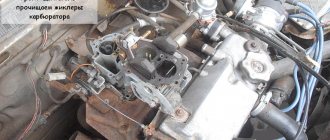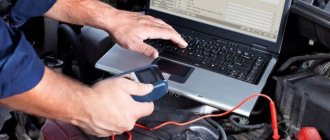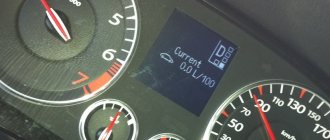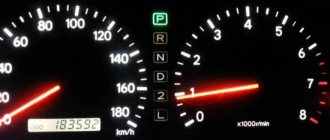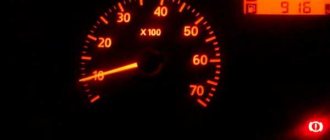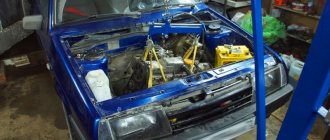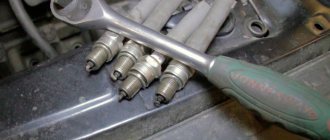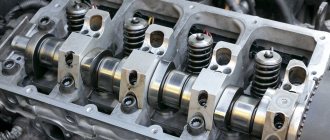Possible reasons why the engine stalls at idle
1. Errors in the operation of the XX regulator.
In modern cars, such a regulator is performed:
- according to a bypass circuit with control of the bypass channel of air supply bypassing the throttle valve;
- throttle valve angle control;
- regulator in the fuel pump.
To accurately determine the cause of the power unit stopping, computer diagnostics is required.
2. Fuel supply interruptions.
Such malfunctions are most often associated with:
- clogging of the fuel and filter system;
- wear of the fuel pump;
- low pressure in the ramp.
First of all, you need to check the pressure in the fuel rail with a pressure gauge.
3. Misfires, engine tripping
. This is usually associated with critical wear of coils, spark plugs, and high-voltage wires.
4. Sensor errors in the power unit control system and electrical equipment.
The most “influential” sensors in internal combustion engines are the crankshaft, camshaft, and mass air flow sensors. An auto scanner is required to check for errors.
5. Air leaks into the intake manifold and intercooler system.
In this case, an incorrect composition of the combustible mixture is formed, which leads to malfunctions of the engine.
6. Poor quality fuel.
This problem is especially common in diesel engines. At low temperatures, fuel may become waxy. As a result of this process, the pressure in the ramp decreases and the engine may stall.
Diesel stalls at idle
The problems described above with gasoline internal combustion engines associated with operation at idle are not spared for diesel engines. A common problem with diesel engines is the malfunction of the high pressure fuel pump (HPFP). Natural wear of the plunger pairs, the presence of impurities in diesel fuel or air leaks from the injection pump leads to the fact that the diesel engine starts and then stalls.
A common malfunction for injection gasoline and diesel cars is also the strainer in the fuel tank. This mesh must be periodically cleaned or replaced. At the same time, it is worth checking the diesel injectors, as well as the operation of the glow plugs.
Troubleshooting sequence
If the effect of stopping the engine at idle occurs, it is necessary to perform the following work sequentially:
- full diagnostics of the car, with decoding of all error codes;
- replacement of faulty sensors, components and modules, the fault of which is indicated by diagnostic results;
- control of fuel pressure in the rail;
- searching for the possible presence of suction in the intake system;
- washing the throttle valve assemblies and the XX regulator with a special agent;
- checking the ignition system components;
- replacing fuel and air filters;
- draining fuel and refilling with high-quality fuels and lubricants.
Source
Checking the IAC electrical circuit.
What can you do yourself when checking the electrical circuit of the idle speed control of a VAZ 2107? Measuring the voltage at the connection block to the control unit and measuring the resistance of the regulator motor windings. To measure you need to have a tester. The diagnostic procedure is given below:
- Disconnect the block with the wiring harness from the regulator. It is located on the throttle assembly.
- Turn on the ignition.
- Set the tester to voltage measurement mode in the range from 0 to 20 volts.
- Connect the probe from the tester with a minus sign to the ground of the car.
- Connect the probe from the tester with the “plus” sign in turn to terminals “A” and “D” on the harness block. The voltage between ground and terminals should be 12 volts. If there is no voltage, the controller may not be corrected.
- Next, move the tester to the resistance measurement position. Measure the resistance of the first winding between terminals “A” and “B”. Measure the resistance of the second winding between terminals “C” and “D”. There should be 52 ohms on both windings. In other variations of measurements between the terminals, the device should indicate an open circuit. If the tester shows the opposite, then the electric motor is faulty.
IAC malfunction.
The electric motor is not the only component in the regulator that can break; there are a number of other breakdowns:
- oxidation of connector contacts, broken wires;
- contamination of the rod, preventing movement;
- the o-ring is torn;
- wear of the screw thread on the rod.
We recommend: Chip tuning: what is good and what is bad
Of the above breakdowns, the most common is contamination of the rod. If during operation the throttle assembly has not been maintained for a long time, carbon deposits on the regulator rod are possible. To remove dirt, you need to remove the IAC and rinse with acetone.
The stem needs to be cleaned periodically. Otherwise, the load increases, which can damage the ECU. Then you will have to contact service station specialists.
Problems in the mass air flow sensor - mass air flow sensor.
The mass air flow sensor is located in the air duct between the throttle valve and the air purification filter. It shows the volume of air entering from the atmosphere into the suction manifold. Based on these data, the control unit calculates the amount of fuel required for the current operating mode of the internal combustion engine.
If the sensor is faulty, the “Check Engine” light on the panel lights up. In parallel with this, a number of signs of failure are possible:
- Fuel consumption has increased.
- Idle speed is increased.
- The dynamics of the car are disrupted due to a decrease in power.
- It is impossible to start the internal combustion engine, even when “hot”.
- The speed changes at any throttle position, even under engine load.
Such sensors are not repaired, but replaced. Therefore, you need to make sure that this is the reason. Often the cause may be contamination of the platinum thread inside the device; it can be cleaned. Or the cause of air leakage through a damaged air duct.
Air leaks through cracks in hoses and seals.
There are many places where excess air can enter the suction manifold, bypassing the mass air flow sensor. The fuel mixture becomes leaner, the speed decreases, and the power drops. The ECU tries to correct these errors. A failure occurs in the system, the speed and “thrust” do not correspond to the specified parameters. The "Check Engine" warning light on the dashboard does not light up. The conclusion from this is that the sensors are working, but the internal combustion engine is sucking in air somewhere.
There are several places for air leaks that you should pay attention to, these are:
- the manifold with its gaskets, all kinds of joints, gaskets under the equipment attached to the manifold;
- vacuum brake booster and its hoses:
- throttle body;
- vacuum pipes.
After eliminating these shortcomings, the power unit will operate normally.
Other reasons.
A car is a complex engineering structure. During operation, its units, components, systems, and blocks are subject to wear. And it is impossible to describe all combinations of breakdowns.
Here are some reasons for the internal combustion engine not working properly:
- The ignition system has many of its own “sores”.
- Nozzles requiring professional care.
- Low quality gasoline.
- Presence of water in the fuel tank.
- Fuel and air filters are clogged.
- Other.
In each case it is necessary to understand, identify cause and effect. If you can’t do it yourself, you should contact a service station specialist.
In this article, “Why do idle speeds fluctuate on a VAZ 2107 injection engine,” the emphasis is on the breakdown of the XX Regulator. If it is broken, it can hardly be repaired. It's better to change it. It’s not difficult to do it yourself, having a new IAC and a minimum of tools.
Why does the engine have unstable idle speed?
If the engine is working properly, when the car starts to start, a warm-up process occurs. At this time, the tachometer needle shows almost 2.5 thousand revolutions per minute; after warming up, the speed decreases. Subsequently, the normal functioning of the power unit is characterized by the tachometer needle being at a level of 750 to 800 rpm.
If a problem arises - the speed fluctuates on a cold engine, this can only mean one thing - serious defects have appeared in the car’s engine, so it works unstably.
In the absence of this device, violations can be determined by the sound coming from the power unit compartment: the rumble and vibration of the engine are noticeable in the form of an increase and decrease alternately. Most often, the engine speed jumps at idle.
Diesel engine stalls at idle
To understand the causes of the malfunction that caused unstable idling, it is necessary to divide cars according to the principle of injection and ignition system, as well as by type of fuel. This engine behavior can also be characterized by a defect in the ignition distributor, high-voltage wires and spark plugs, as well as the adjustment of the ignition system itself.
If the fuel pressure is lower than specified, it is necessary to replace the fuel pump and, accordingly, the fine and coarse fuel filters. Often, all fuel system malfunctions occur when using low-quality fuel.
It is also worth noting, but this is a rather rare case, the lack of idle is due to a heavily contaminated air filter, the remedy is to replace the filter element.
Elimination is carried out by washing with a special composition and, if necessary, replacing failed sensors.
Checking the sensors can be done by comparing the resistance with the reference one. As for cars with two types of fuel, it is characterized by all the faults described in the column of gasoline engines with minor additions.
And don’t forget that timely maintenance of all car systems will greatly increase the service life of your iron horse and ensure trouble-free operation of all systems.
Interruptions in the operation of carburetor and diesel engines
Why do engine speeds fluctuate in carburetor cars? Unstable activity may be caused by the following reasons:
- Failure of adjustments in idle modes.
- Failure of the carburetor engine solenoid valve.
- Excessive accumulation of combustion products in the nozzle.
Diesel engines have jumps and drops in the instrument readings during intermediate modes and when idling.
In these cases, they say that the diesel engine speed is floating. The cause is rust formed on the impeller of the high pressure fuel pump. Water contained in diesel fuel causes corrosion.
Consequences of unstable motor activity
All of the above reasons for engines running intermittently cause a number of negative consequences:
- increased consumption of gasoline or diesel fuel;
- environmental pollution with exhaust gases containing an increased percentage of harmful gases;
- increased wear of components and parts of the power unit.
List of measures to eliminate floating revolutions.
To restore stable idle speed, do the following:
- Restoring the air suction function in the engine cylinders.
- Check and subsequent replacement, if necessary, of the IAC.
- Cleaning the ventilation valve.
- Diagnostics of the hot-wire anemometer and its subsequent replacement.
- Cleaning and restoration of the throttle valve.
- Setting up idle modes.
- Replacing the carburetor solenoid valve.
- Cleaning the jet.
- Removing rust from the fuel injection pump impeller.
Description of actions to eliminate speed instability
When carrying out measures to restore air leaks, the tightness of the lines supplying air to the collector is checked.
Each tube is removed and purged using a pump or compressor. Additionally, a WD 40 solution is used. Where the liquid evaporates quickly, the integrity of the line is compromised, in which case the hose must be replaced with a new sample.
To diagnose the idle air control valve, use a multimeter to measure its resistance. If the resistance value is 40–80 Ohms, the regulator needs to be replaced.
The crankcase is disassembled to remove the ventilation valve and then washed in kerosene to remove oil deposits. After thorough drying, the valve is returned to the ventilation system.
If the mass air flow sensor fails, it is replaced with a new one.
When cleaning the throttle valve, special aerosols, a brush, and rags are used. This procedure can be performed directly on the engine, which has had time to warm up, or by removing it from the power unit. The appearance of white smoke indicates that oil sludge has been removed. After flushing and installation are completed, the dampers are reprogrammed to set the nominal opening gap.
A breakdown of the solenoid valve contributes to the occurrence of jumps in engine speed. This item cannot be restored and must be replaced.
The jet is cleaned using a special aerosol liquid used when washing carburetors. The product is poured into the nozzle, after five minutes the cleaning liquid is removed using compressed air.
To treat the fuel injection pump impeller, a special agent is used to remove traces of corrosion. It is sprayed directly into the neck before pouring fuel. Cleaning the inside of the tank is done using this product. To prevent corrosion, 200 grams of engine oil is poured into the fuel tank to protect the blades.
If the engine starts to jump at idle, the speed is disrupted when the engine warms up, you need to undergo diagnostics at a service station in order to check and restore the integrity of the components and parts of the power unit systems.
Source
Why does the injector stall at idle?
The advantage of VAZ injection systems, which were first installed on the 2110 family, and then on the subsequent G8, slightly updated in appearance 2114-2115, is that they are simple in design, and as a general example of injection system malfunctions are the most obvious.
The injection ECU has feedback algorithms and influences the idle speed both grossly (using the idle speed controller or “electronic” throttle) and subtly (by varying the ignition timing), so it is more difficult to make the injection engine stall. In addition, the abandonment of the distributor and the installation of either a dual ignition module (eight-valve models) or individual coils (sixteen-valve engines) also increased the reliability of the ignition system: at least on two cylinders, the engine will work. Air leaks have also become less critical. The revolutions will begin to fluctuate, but if the idle speeds disappear, then the reason is hidden elsewhere.
The car stalls at idle: causes and solutions
There were no signs of trouble: the car started up easily and worked perfectly. The time comes to take your foot off the gas pedal and the revs immediately begin to drop. The car stalls at idle, stops and the ride suddenly stops. Most car owners have encountered a similar situation with gasoline and diesel at least once in their lives.
The most common reasons:
- incorrect operation of the idle speed sensor;
- failure of the sensor responsible for the throttle position;
- throttle contamination;
- contamination of the carburetor or injector in the engine.
Since these reasons are little related to each other, diagnostics can take a lot of time, and not every car owner is able to carry it out on their own. These breakdowns are not considered serious and their elimination does not require much effort.
Problems with carburetor engines
The idle system in the carburetor is the most sensitive to contamination. Therefore, if a carburetor engine stalls at idle, it is worth blowing out the jets and channels of the idle system, and on cars with electronic forced idle control, also check the operation of the economizer solenoid valve. On Solex carburetors (VAZ 2108-2109), the idle fuel nozzle is mounted on the solenoid valve rod, and if there is no voltage on the valve, it is closed. To make sure that the valve is at fault, on these carburetors it is enough to unscrew it slightly to remove the pressure of the jet against the body and allow fuel to flow past the blocked jet. Has the idle speed stabilized? This means that either the EPHH unit does not supply voltage to the valve (which is checked with a light bulb or a tester), or the valve itself is inoperative.
There are not many reasons why a valve control unit may not supply voltage to it. In addition to the malfunction of the unit itself, this is a loss of power at pin 4, a broken connection with the ignition coil (the EPHH unit stops “seeing” engine speed), and the absence of “ground” at the carburetor end (pin 5) when the gas pedal is released.
Note that a common problem with carburetors is the rigid connection between the composition of the air-fuel mixture from the vacuum and the fuel level in the float chamber. If any of these parameters change, the composition of the mixture will also “float away”. It will go beyond the limits of normal ignition - if the car does not idle until it warms up, then the mixture is over-lean, but if the car stalls when hot, then over-richness is already occurring.
A change in vacuum at idle is a consequence of air leaks through the vacuum lines (for a VAZ, this is often a vacuum brake booster or a vacuum distributor corrector) or a violation of the tightness of the joint between the carburetor and the manifold. Here, Solexes have a long-known disease with warping of the mating plane of the body; Ozones show themselves better in this regard.
The ignition on carburetor cars in the vast majority of cases is distributor-type, with the exception of two-cylinder engines, where it is enough to use a two-terminal coil without spark distribution. If the motor stalls and does not start, then the problem is hidden until the spark is emitted - look at the breaker contacts, the central high-voltage wire, the carbon contact connecting the cover and the slider.
We recommend: Kubota is a masterpiece of design thought.
Problems with spark plugs are common to both carburetor and injection engines. This includes natural wear, which under normal conditions proceeds evenly; sooner or later all the spark plugs in the set will begin to work intermittently, and carbon deposits due to low-quality fuel or a violation of the mixture composition (over-enrichment, carbon black carbon deposits damage the spark plugs). Iron-containing additives (the notorious ferrocene) can “kill” spark plugs in one unsuccessful refill. So you should immediately pay attention to the candles, especially if access to them is not difficult.
Common problems on all engines at idle
There are a number of problems that are typical for all power plant designs. Due to the design features of internal combustion engines, at idle speed, malfunctions and interruptions in operation stability may occur.
Problems with carburetor engines
- Idle jet clogged. When using low-quality fuel, thin passages can become clogged with debris or grains of sand, which causes unstable engine operation.
- Low permeability of air and fuel lines. If there is insufficient amount of fuel or oxygen, the power plant does not hold idle well and may stall.
- Incorrect ignition setting or system problem.
Why does the injector stall at idle?
The injector is characterized by the presence of factors:
- incorrect operation of the computer;
- clogged injectors;
- failure of individual sensors.
Diesel won't idle
They are capricious due to the following reasons:
- problems with the injection pump system;
- insufficient purity of diesel fuel;
- breakdowns within the fuel or air line system.
They may stall in winter due to fuel freezing.
Trouble-shooting
Often there is no fundamental difference which engine is installed in a vehicle - the reasons that the engine stalls will be the same. In carburetor-type engines, a common reason for the engine stopping at idle may be an unadjusted drive, a dirty needle valve, or other problems. To eliminate such malfunctions and improve engine performance, change the fuel filter regularly. If the solenoid valve fails, the speed twitches or drops completely.
When the characteristic clicking sound is not heard when connecting, it is better to replace the valve. In diesel engines, the main role is played by the high pressure fuel pump. If this unit fails, the quality of the fuel, the condition of the electrical wiring, glow plugs and other parts are checked, and the fuel filter is changed. In injection engines, the air filter is first cleaned; it is possible that it will have to be replaced. If vibration is felt at idle, it is recommended to replace the gasket. Also, to eliminate the causes of engine shutdown, the injectors on the engine or on a special device are washed.
Sources
- https://topmekhanik.ru/pochemu-mashina-glohnet-na-holostom-hodu/
- https://scart-avto.ru/remont/glohnet-mashina-na-hodu-na-holostyh-oborotah-no-potom/
- https://www.avtogide.ru/pochemu-mashina-glohnet-na-holostom-hodu.html
- https://autochainik.ru/mashina-glokhnet-na-holostyh-oborotah.html
- https://zen.yandex.ru/media/id/5d39599e92414d00ac68c5ab/propal-holostoi-hod-dvigatelia-pochemu-5eaf924479cddb12c53006d9
- https://nivovod.ru/remont/dvigatel-na-holostom-hodu-glohnet-ili-nestabilno-rabotaet/
[collapse]
Common causes of engine stalling at idle
Separately, the most common problems leading to engine failure without an applied load should be described.
The idle speed controller is faulty
The problem is typical for injectors and modern internal combustion engines. A smart unit often fails due to mechanical damage, natural wear, or incorrect calibration.
The electronic regulator has several weaknesses:
- signal sensors;
- control relays;
- fuse system.
Throttle valve dirty
A sensitive throttle often becomes the reason for visiting a service station. In the idle position, the damper on most designs opens only partially. When carbon deposits appear on the surface of the valve, the passage opening decreases. The negative effect reduces the idle speed or may cause engine failure.
To fix the problem, just clean the mechanism and put it back in place.
Idle fuel jet clogged
Frequent breakdowns in carburetor engines. The fuel jet is a screw with a thin hole drilled inside. If low-quality fuel is used, or rust appears in the gas tank, the line becomes clogged, which prevents the free passage of liquid.
Fuel pump malfunctions
The engine behaves similarly when this part wears out or malfunctions. When the internal combustion engine is idling, the working part of the unit rotates slowly, the pressure in the fuel system is minimal. When the pump impeller wears out, its performance drops noticeably. The effect is especially noticeable at idle speed.
Fuel filter dirty
The following problem is common to all power plants, regardless of the design and type of fuel consumed. When the filter element is clogged, the throughput of the device is reduced to a minimum. An amount of fuel that is insufficient to maintain stable engine operation enters the combustion chamber.
Malfunction of the mass air flow sensor
The mass air flow sensor is responsible for reading and adjusting the supplied air flow. If the sensor transmits incorrect information, the ECU will not adjust the fuel mixture correctly. Consequently, the power unit will fill or lack gasoline.
Contamination of the crankcase ventilation system
It may become clogged due to the use of low-quality oil, fuel or lack of maintenance.
When excess pressure appears inside the crankcase, the system stops functioning normally, excess pressure is created in the engine and the internal combustion engine stops working.
Gasoline engine does not idle
Let's start with the fact that this malfunction indicates two possible causes: failure of individual mechanisms, components or sensors, as well as severe contamination of certain elements. In both the first and second cases, it is necessary to carry out a diagnosis. The engine on injection and carburetor cars can most often stall at idle in the following cases:
- the idle air regulator (IAC) has failed;
- the throttle valve is dirty or malfunctioning;
- the carburetor channels are clogged or the fuel jet XX is dirty;
- the performance of injection nozzles is reduced or impaired;
- the mesh of the electric/mechanical fuel pump is clogged, malfunctions of this unit have occurred;
- there was a decrease in the throughput of the fuel filter;
- the air filter is dirty, air leaks at the inlet;
- failure of the mass air flow sensor, throttle position sensor, etc.;
- clogging of the engine crankcase ventilation system;
We also recommend reading the article on how to replace the mesh filter on the fuel pump yourself. From this article you will learn about methods for removing the fuel pump to replace the mesh, and also find useful tips for successfully implementing this process.
If the car immediately stalls or the speed fluctuates noticeably after the starter is turned off, then you should pay attention to the throttle assembly. It is possible that the valve may become clogged or the mechanism may become jammed. This malfunction, especially severe contamination, occurs as a result of prolonged driving on low-quality fuel, as well as untimely replacement of the air filter.
In this case, the throttle valve needs to be cleaned. To clean the throttle, use a regular “carbicleaner” (a product for cleaning carburetors), and you also need to blow out the valve using compressed air from the compressor. If these steps do not help, then you will need to evaluate the condition of the oil trap. This element is an integral part of the engine crankcase ventilation system. A dirty oil trap causes crankcase gases to “choke” the engine, idle speed floats and the internal combustion engine stalls.
Now let's look at a situation where the car starts normally, but then starts to stall (constantly or with a certain frequency). A similar situation often occurs on fuel-injected cars that have an electronic engine control system (ECM).
The cause of unstable engine operation may be electronic sensors, as well as the idle air control (IAC). You should check the regulator itself, the air flow meter (MAF), and the throttle position sensor (TPS).
It is advisable for owners of cars that have been in use for a long time to have these sensors in stock, as well as a multimeter for self-diagnosis. This is especially necessary if the car is often used for long trips along the highway. Note that most of these sensors have an acceptable cost.
We also recommend reading the article on how to check the camshaft sensor yourself. From this article you will learn about the purpose of this sensor, as well as the available ways to check it yourself.
Another important point is that the car may start to stall at idle after flashing the ECU. Unprofessional correction of the factory firmware, flashing or chip tuning of the electronic engine control unit can lead to failures. Although the engine after such actions demonstrates better performance under load, at high speeds, etc., in parallel, the unit is not able to operate normally at 750-800 rpm. In this case, the installed firmware should be adjusted to achieve stable operation of the internal combustion engine in all modes.
Now a few words about the carburetor. The engine often stalls on such engines precisely because of contamination of the jets and prolonged lack of proper carburetor adjustment. The fact is that even small particles of debris in the fuel can disrupt the operation of carburetor injection. Dirt can be contained either in low-grade gasoline or enter the system from the gas tank, in which deposits gradually accumulate.
You should start by replacing the fuel filter in front of the carburetor, and then move on to the device itself. The carburetor usually only needs a good cleaning and subsequent adjustment. To clean the carburetor injection, that is, the metering device itself, it is necessary to use a special means for cleaning carburetors.
This product is a solvent-cleaner in an aerosol can. As for the mechanical fuel pump of carburetor engines, this type of pump has a filter mesh. This element can also become clogged, reducing pump performance. The membrane of a mechanical fuel pump can also fail. In parallel with wear, membrane particles clog the channels in the carburetor.
With an injection system on an injector, the situation is more complicated. If replacing the ECM sensors does not help, then you should start checking the intake manifold for excess air leaking into the intake, and also eliminate air in the fuel system. Then you need to move on to checking the injection nozzles, measure the pressure in the fuel rail, inspect the vacuum hoses, etc. The vacuum brake booster will require special attention. We also add that regardless of the type of injection (engines with an injector or carburetor), it is necessary to check the ignition, spark plugs, high-voltage wires, distributor coil and other elements of the system.
What to do first
It’s good if it is possible to carry out computer diagnostics at a service station. The devices make it possible to identify faults in individual parts of the machine not only more accurately, but also noticeably faster than with traditional methods.
Problems with sensors and other electronics
If you have a modern car, you should check the serviceability and settings of sensors and units. Such problems are often found using computer diagnostics. In a modern car design, correct operation of the sensors guarantees stable engine operation by 90%.
Electrical problems
On carburetors, the ignition timing setting may be lost. Regardless of the type of internal combustion engine, spark plugs, coils, relays and fuses fail or malfunction.
Mechanical problems
- carburetor;
- throttle valve condition;
- fuel/air line;
- pumps;
- filter elements;
- wear of the cylinder-piston group.
If the problem cannot be found, you should contact a service station.
The engine stalls at idle: solving the problem
When making repairs yourself, you may need to carry out the following actions:
- complete replacement of sensors;
- restoration of the performance of individual elements, whose life can be extended;
- preventive work to avoid recurrence of problems of this kind.
Complete replacement of broken equipment is required when some devices break down. When the engine stalls, it cannot be avoided if the reason lies in faulty throttle or idle position sensors. Often they prefer to replace the throttle valve itself. The carburetor or injector is replaced only if cleaning does not help.
The engine turns off periodically when idling
It does not play any role, the car engine turns off sometimes or with a certain regularity - the causes and solutions to the problem do not change. The main thing to remember is that even a small frequency of occurrence of a problem is a sign of poor performance of the car’s internals.
The car starts to “cough”, the engine stalls after starting
Blocks to check:
- ignition system;
- correct setting of mixture formation;
- quality of the fuel used.
The car stalls at idle even though it starts
If the car, after starting the engine, jerks when you press the gas, the speed is unstable, and then drops completely and it stalls, then the fault probably lies with the fuel pump or dirty filters. You can learn more about the problem from the video.
The car starts and stalls immediately after the starter is turned off.
If this problem occurs, it is recommended to check the serviceability and calibration of the modules:
- immobilizer setting;
- correct setting of the alarm mode;
- serviceability of the ignition switch.
Car stalls at idle when cold
The problem is common on the Opel Corsa car. The car cuts out at idle if the engine is not warmed up. The same thing happens with cars of other brands. The reasons are the same:
- unexpected vacuum leak;
- breakdown of spark plugs;
- rotor failure;
- problem with the distributor cap;
- The engine ignition timing is set incorrectly;
- malfunctions in the electronic control unit;
- problems with the recirculation valve;
- wear of power plant elements or mechanical damage;
- contamination of fuel injectors;
- Incorrect operation of the cold speed regulator.
Some faults can only be identified with the help of special equipment. Especially, incorrect operation of the electronic control unit (ECU).
The engine stops idling when the engine is hot
You have a relatively new Priora, you start the car and with the engine warm, press the gas, release the pedal and suddenly it starts to stall. This picture is familiar to many car enthusiasts who own this model and several others similar to it. The reasons why a car stalls when heated are not all, but they are similar to problems with a cold engine. Unless the cold speed sensor plays no role here.
Reasons for stopping the engine at idle
Car owners and service station workers agree that the reasons for engine stalling can be:
- malfunction of the idle speed sensor, or its partial malfunction;
- malfunction of the throttle position sensor;
- presence of blockage in the throttle valve;
- clogging of the carburetor or injector (depending on the type of car).
It happens that the problem may be low quality fuel or its absence in the tank, as well as other malfunctions. If the breakdown is more serious than it seems, then it is better to contact a service station.
Carburetor engine
Carburetor is a component of the internal combustion engine power system designed to mix flammable liquid with air and supply it to the engine cylinders. The operating principle of such an engine is that the fuel, compressed in the combustion chamber, is ignited by an electric spark. Based on the number of cyclic cycles, carburetors are divided into four-stroke, two-stroke and four-stroke with a half-turn of the crankshaft. In carburetor engines, problems with idle stop occur mainly due to mechanical failure or simple contamination of engine parts.
Causes of malfunctions in a carburetor engine that cause the engine to stall:
- malfunction of the idle speed control - the engine will either stall immediately after turning the key in the ignition, or the speed will either increase or decrease (fail). The sensor rod blocks the air passage - the engine stops;
- the throttle valve is dirty - the valve does not block the air supply channel. The reason may be the formation of plaque entering through the air-fuel mixture ventilation system, the use of low-quality fuel, or a dirty air filter;
- failure of the idle speed solenoid valve, power failure - does not draw in the nozzle, which blocks the idle speed channel. The same situation is repeated in the jet itself if its holes become clogged;
- the float is jammed in the carburetor, the shut-off valve needle is blocked - the fuel supply stops, the engine stops. This problem occurs due to the accumulation of plaque, small debris in the fuel filter;
- malfunction of fuel injectors provokes interruptions or lack of idling;
- the fuel pump does not supply fuel in the required quantity to the carburetor - the engine does not receive the required amount of gasoline;
- contamination of filters (air and fuel) changes the qualitative composition of the fuel - the engine malfunctions and may stall;
- Dirty channels of the crankcase ventilation system increase the pressure of the combustible fuel-air mixture, which has an aggressive effect on the engine.
Injection engine
An injector is a fuel supply system, the main principle of which is to forcefully supply fuel (liquid or gas) into the cylinder. There are two types of injection - central (one injection nozzle) and distributed (many nozzles, each supplying fuel to one cylinder). To understand the reason why the injection engine stops at idle, you need to understand what functions its elements perform:
- The electronic control unit (ECU) controls the operation of the entire engine system, which receives data from the external environment, as well as about the operation of the engine. The received data is transmitted to the instrument panel;
- The pressure regulator is responsible for constant pressure in the injectors;
- supplies fuel to the injector cylinders (electromagnetic, piezoelectric, electrohydraulic);
- The fuel pump is responsible for supplying fuel to the fuel tank;
- In order for the entire system to function smoothly, several types of sensors work (knock, throttle position, voltage phases, air flow, crankshaft position).
We recommend: The engine constantly idles: we carry out diagnostics
The most common reasons for a drop in speed and engine stalling:
- The idle speed control is faulty;
- the level of pressure of the combustible mixture or air leakage is insufficient;
- the car's electronic system is faulty;
- air system flow sensors malfunction;
- spark plugs are not working.
Diesel won't idle
To understand why the engine stops at idle, you need to study a little about the principle of operation of this system. A diesel engine works like this: fuel is injected into the cylinder under high pressure, while the air in the cylinder is compressed 16-25 times. High temperature causes small particles of diesel fuel to compress, causing these particles to ignite and combustion of diesel fuel. Gases expand the piston, it goes down, that is, it makes reciprocating movements. The reasons for a diesel engine stopping at idle may be:
- failure of fuel to enter the high pressure fuel pump;
- absence of a signal from the crankshaft position sensors entering the control unit.
- there is no way to regulate high pressure within specified limits (the most common reason for engine shutdown).
- depressurization of the high pressure system - the injector elements wear out and the fuel that is discharged into the return increases. It reaches volumes at which the system is unable to maintain the required pressure in the rail;
- mechanical wear of high pressure fuel engine parts;
- debris entering the internal pressure valve filter.
Stopping a classic engine running on diesel fuel occurs for the same reasons as in modern engines.
